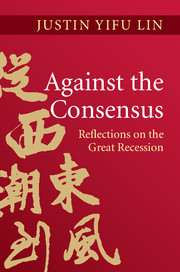Book contents
- Frontmatter
- Contents
- List of figures
- List of tables
- List of boxes
- Preface
- Overview
- Part I What Caused the 2008–9 Global Crisis?
- 1 The world economy and the 2008–9 crisis
- 2 The real causes of the crisis
- 3 Financial deregulation and the housing bubble
- 4 What’s wrong with the Eurozone
- 5 Why China’s reserves have risen so much
- Part II A Win-Win Path to Recovery
- Part III How Poor Countries Can Catch Up: Flying Geese and Leading Dragons
- Part IV Toward a Brave New World Monetary System
- References
- Index
2 - The real causes of the crisis
from Part I - What Caused the 2008–9 Global Crisis?
Published online by Cambridge University Press: 05 June 2013
- Frontmatter
- Contents
- List of figures
- List of tables
- List of boxes
- Preface
- Overview
- Part I What Caused the 2008–9 Global Crisis?
- 1 The world economy and the 2008–9 crisis
- 2 The real causes of the crisis
- 3 Financial deregulation and the housing bubble
- 4 What’s wrong with the Eurozone
- 5 Why China’s reserves have risen so much
- Part II A Win-Win Path to Recovery
- Part III How Poor Countries Can Catch Up: Flying Geese and Leading Dragons
- Part IV Toward a Brave New World Monetary System
- References
- Index
Summary
Several years after the crisis there is still no consensus on its root cause. Debate focuses on global imbalances and the relative importance of domestic and international factors in the emergence of the US housing bubble. Two main hypotheses have been proposed.
One hypothesis is that East Asian and Chinese economic policies led to a global savings glut that lowered interest rates, stimulating unbridled financial sector growth and inflating the US housing bubble. The export-led growth strategies, efforts to self-insure against a future balance of payments crisis, and the undervaluation of the Chinese currency resulted in large and unmanageable current account surpluses and international reserves. Systematic export promotion by China and East Asian economies through a variety of macroeconomic and microeconomic policies, including dumping, was viewed as the main cause of the global imbalances. Contributing factors were the desire to self-insure by accumulating international reserves as a buffer against a repeat of the 1998 balance of payments crises, when many of these countries had to request financial assistance from the International Monetary Fund. The claim that the Chinese authorities were keeping the value of the yuan artificially low to boost export competitiveness has been repeatedly mentioned as a key factor behind China’s rising trade surplus and global imbalances.
- Type
- Chapter
- Information
- Against the ConsensusReflections on the Great Recession, pp. 14 - 32Publisher: Cambridge University PressPrint publication year: 2013



